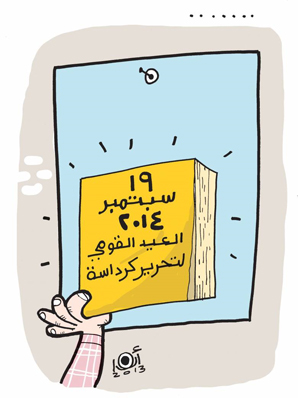 |
|
Political Cartoon published in Al-Masry Al-Youm, one day after the assault on Kirdasa (20/9/2013)
|
Introduction
The violent break-up of the protest camps at Rabia al-Adawiya and al-Nahda on August 14, 2013 not only has dire consequences for the political process in Egypt, but it also indicates that heavy-handed security measures might open the country up possibility to the possibility of civil unrest that might take on an extreme tribal, regional, or religious form. The Wiki Thawra site, a statistical database of the Egyptian Revolution, lists more than 295 instances of clashes in the month following the break-up of the two protest camps, ranging from clashes between groups of civilians, to others involving the police and army, armed attacks on public facilities, the violent dispersal of sit-ins, sectarian clashes and extra-judicial killings.
During that month, the massacre at the police station in the town of Kerdasa—located in Giza governorate—stood out. A group of armed and masked assailants attacked this police station with live fire and rocket-propelled grenades. They killed 13 policemen in revenge for the breakup of the Rabia al-Adawiya and al-Nahda protest camps, when a number of local people were killed. This was not the only incident of its kind in Egypt. Wiki Thawra lists 68 similar occurrences throughout Egypt in which people took revenge against state institutions in response to locals being shot and killed by the security forces. The sheer bloodiness of the violence in Kerdasa and its subsequent coverage in the media marked it, and led the townspeople to endure a form of collective punishment.
This analysis attempts to understand the reasons Kerdasa was different than other small and medium-sized Egyptian towns that were, until relatively recently, no more than villages. This is done through a reading of the social and historical background to the solidarity found among its people and how this was expressed before and after the July 3, 2013 military coup. Kerdasa is then presented as a paradigm for understanding the Egyptian security forces’ policy for dealing with rural Egypt.[1]
*This study was translated by the ACRPS Translation and English Editing Department. The original Arabic version can be found here.
[1] Parts two and three of this article are based on testimonies collected via email and telephone. Apart from Professor Sayyid al-Nazili, all of the witnesses preferred remain anonymous owing to the current security situation in Egypt. These people also provided links to videos on the Internet that document what happened in detail. I wish to thank my friend Mr. Mohammad Abbas, former member of the Coalition of Revolutionary Youth, for his assistance in getting in touch with the people of Kerdasa.